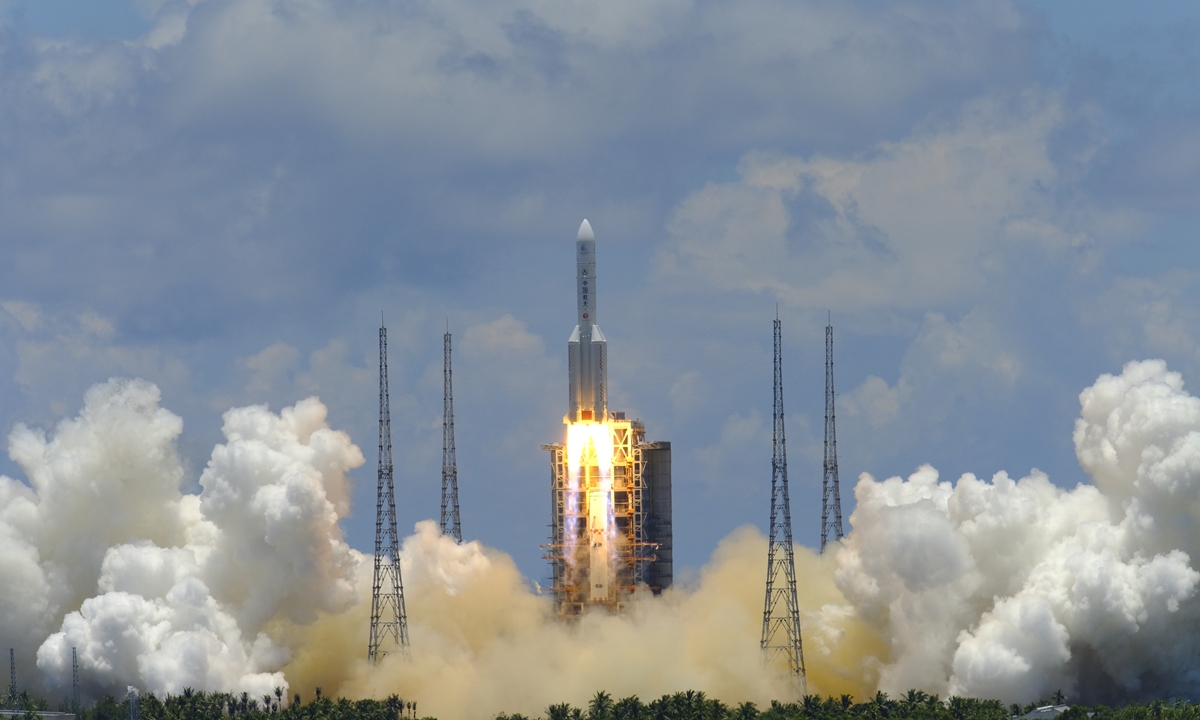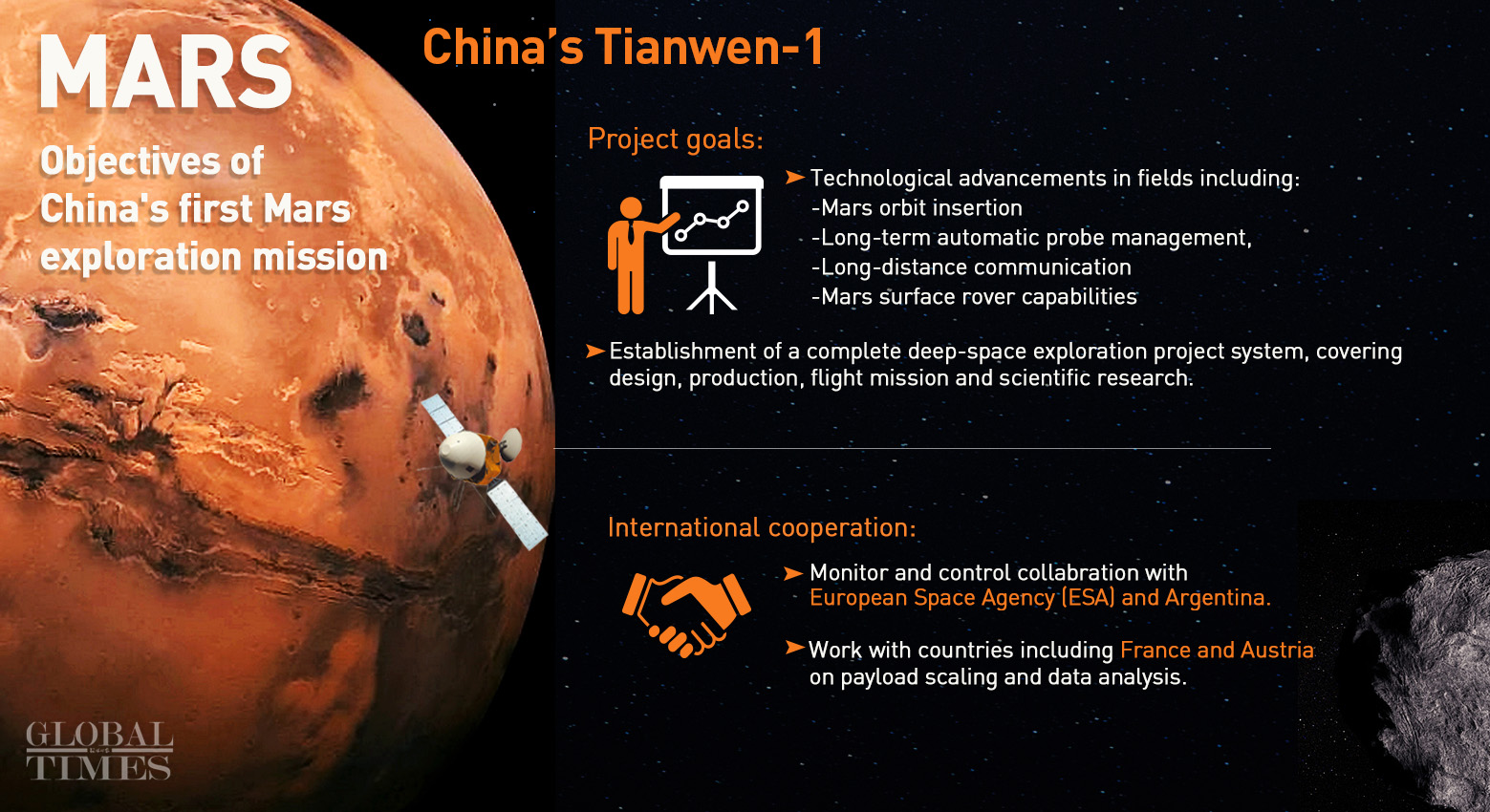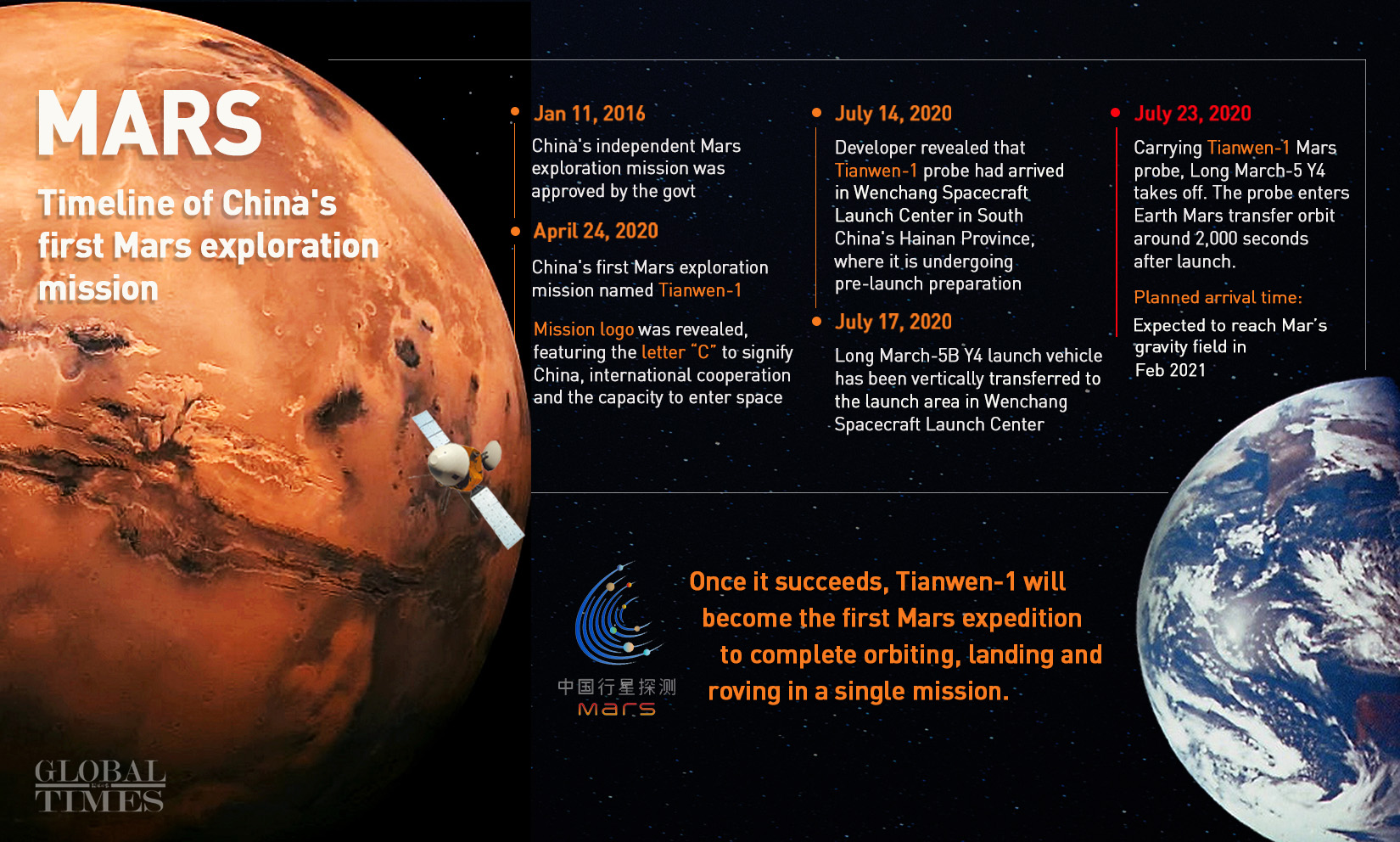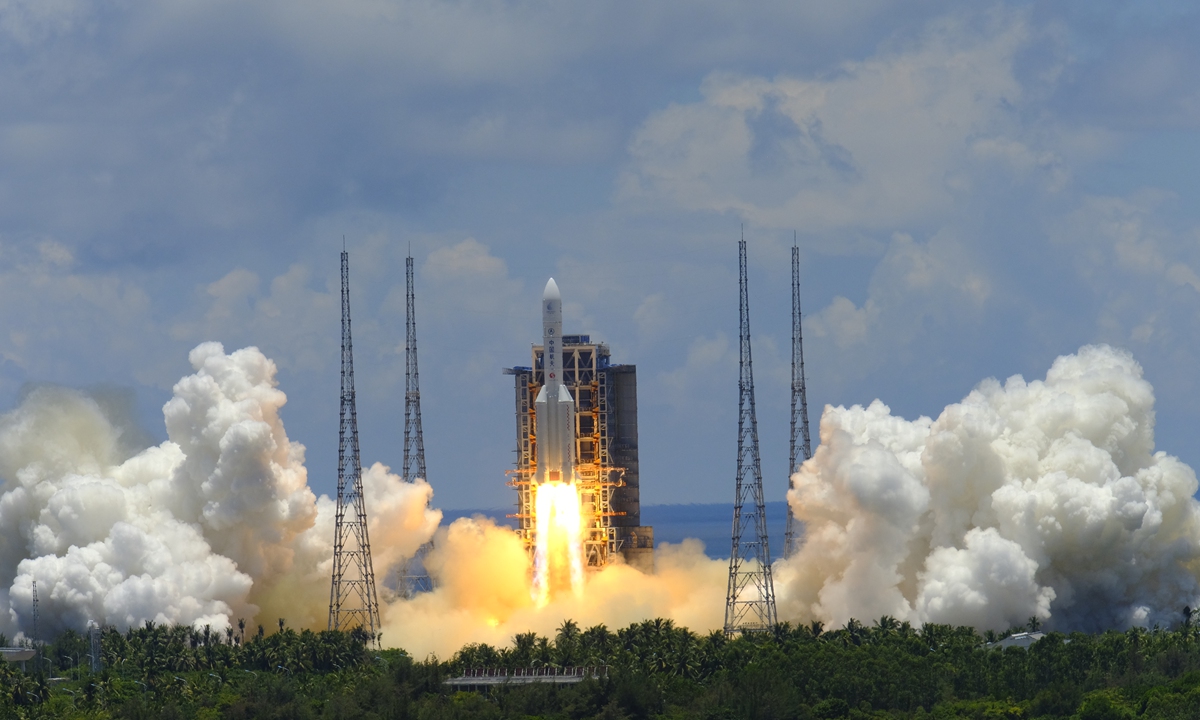China’s successful launch of Mars mission heralds new era of deep-space probes beyond the Moon
By Deng Xiaoci Source: Global Times Published: 2020/7/23 12:42:03 Last Updated: 2020/7/24 12:35:01
Mission marks nation's official start of interplanetary probe era

China successfully launched its first Mars probe, named Tianwen-1, via a Long March-5 Y4 carrier rocket from Wenchang Space Launch Center in South China’s Hainan Province into planned orbit on Thursday. The move heralds a new era in China’s deep-space exploration, which has steadily progressed beyond moon probes to interplanetary missions, mission commanders and developers said.
After a flight of around 2,000 seconds, the probe entered the planned Earth-Mars transfer orbit, officially embarking on its journey to the Red Planet, according to the China National Space Administration (CNSA) on Thursday.
China’s Tianwen-1 Mars probe is expected to reach Mars’ gravity field in February 2021, about seven months after the launch. Rover of the probe is scheduled to soft land on a suitable location in the southern part of Mars' Utopia Planitia around May 2021, Liu Tongjie, spokesperson for China’s Mars probe mission said during a Thursday press conference following the launch.
If it succeeds, Tianwen-1 will be the first Mars expedition to complete orbiting, landing and roving in a single mission in humanity’s history.
According to the CNSA, the project is set to achieve a series of technological advances, including Mars orbit insertion, long-term automatic probe management, long distance communication and Mars surface roving capabilities.
The interplanetary mission will also mark China’s establishment of a complete deep-space exploration project system, covering design, production, flight mission and scientific research.
Global Times reporters found on Thursday that the body of the Long March-5 Y4 is decorated with multiple international space agencies’ logos, such as those of the European Space Agency, French space agency CNES and the Austrian Research Promotion Agency (FFG), which strongly indicates that the mission also involves international cooperation.
CNSA told the Global Times that the European Space Agency and Argentina will participate by taking part in spacecraft monitoring and controlling. Moreover, China is also working with countries including France and Austria on payload scaling and data analysis for the mission.
Interestingly, according to the Xi’an Satellite Control Center on Thursday, China’s first overseas deep-space ground station located in Argentina’s Patagonian region would capture the flying Tianwen-1 probe for the first time for monitoring work during the spacecraft’s first lap on transfer orbit. And ground stations in Jiamusi in Northeast China’s Heilongjiang Province and Kashi prefecture in Northwest China’s Xinjiang Uygur Autonomous Region will join the monitoring work.
After a flight of around 2,000 seconds, the probe entered the planned Earth-Mars transfer orbit, officially embarking on its journey to the Red Planet, according to the China National Space Administration (CNSA) on Thursday.
China’s Tianwen-1 Mars probe is expected to reach Mars’ gravity field in February 2021, about seven months after the launch. Rover of the probe is scheduled to soft land on a suitable location in the southern part of Mars' Utopia Planitia around May 2021, Liu Tongjie, spokesperson for China’s Mars probe mission said during a Thursday press conference following the launch.
If it succeeds, Tianwen-1 will be the first Mars expedition to complete orbiting, landing and roving in a single mission in humanity’s history.
According to the CNSA, the project is set to achieve a series of technological advances, including Mars orbit insertion, long-term automatic probe management, long distance communication and Mars surface roving capabilities.
The interplanetary mission will also mark China’s establishment of a complete deep-space exploration project system, covering design, production, flight mission and scientific research.
Global Times reporters found on Thursday that the body of the Long March-5 Y4 is decorated with multiple international space agencies’ logos, such as those of the European Space Agency, French space agency CNES and the Austrian Research Promotion Agency (FFG), which strongly indicates that the mission also involves international cooperation.
CNSA told the Global Times that the European Space Agency and Argentina will participate by taking part in spacecraft monitoring and controlling. Moreover, China is also working with countries including France and Austria on payload scaling and data analysis for the mission.
Interestingly, according to the Xi’an Satellite Control Center on Thursday, China’s first overseas deep-space ground station located in Argentina’s Patagonian region would capture the flying Tianwen-1 probe for the first time for monitoring work during the spacecraft’s first lap on transfer orbit. And ground stations in Jiamusi in Northeast China’s Heilongjiang Province and Kashi prefecture in Northwest China’s Xinjiang Uygur Autonomous Region will join the monitoring work.

Infographic: Global Times
The Thursday launch mission was the fifth flight of the Long March-5 carrier rocket series, the strongest member of China’s launch vehicle family. The last launch mission of the Long March-5B, a smaller variant of the Long March 5, took place on May 5, also from the Wenchang Space Launch Center in Hainan.The Thursday launch also marked the first time the Long March-5 was put into practical mission use, the rocket developer China Academy of Launch Vehicle Technology (CALT) under the state-owned space giant China Aerospace Science and Technology Corporation (CASC) told the Global Times on Thursday.
“The completion of the first practical mission would indicate that the Long March-5 series has officially joined service,” Wang Jue, chief commander of the Long March-5 rocket model, told the Global Times.
Long March-5 has a 5-meter diameter core stage and four 3.35-meter diameter boosters, and is 57 meters long with a take-off weight of around 870 tons and thrust of 1,000 tons. It has raised the country’s Geostationary Transfer Orbit (GTO) launch capability from 5.5 tons to 14 tons.
The Long March-5 Y4 carrier rocket has reached an escape velocity of over 11.2 kilometers per second, managing to send the probe into planned orbit, and according to Li Dong, chief designer of the Long March-5, “this speed set a new fastest flight speed record for China’s launch vehicles.”
The Tianwen-1 Mars probe, which weighs about five tons, is also the heaviest deep space probe that China has ever sent into space, and is one ton heavier than the Chang’e-4 lunar probe, which China successfully sent to the dark side of the moon in January 2019, the CALT noted.
The powerful launch capability of the Long March-5 rocket has advanced the country’s deep-space exploration to a new starting point in interplanetary expeditions, and a new era of planet probes beyond the moon has officially been ushered in as the first Mars probe begins, Li Minghua, CALT’s Party chief, announced upon the successful launch on Thursday.
The Long March-5 carrier rocket is expected to launch another Chang’e-5, weighing about eight tons, which aims to undertake the country’s first moon sample return mission, set to take place before the end of this year. The Long March-5B will launch the core module of the country’s first space station around March 2021, Lou Luliang, the rocket series vice chief designer, revealed to the Global Times.

Infographic: Global Times
Challenges ahead
Mars, one of Earth’s closest neighbor planets in the solar system, has the most similar environment to Earth's. As of June 2020, human beings have made 44 Mars mission attempts, and only 24 of them succeeded.
The minimum distance between Mars and Earth is about 55 million kilometers, and the two planets only come that close every 26 months. The Mars exploration window is open between July and August.
No country other than China has ever set the goals of orbiting, landing and roving the Red Planet in its first mission attempt, and the successful launch will only mark the beginning of a long expedition full of challenges, and uncertainties also remain, observers noted.
According to the CASC on Tuesday, only a handful of Mars missions have been able to land on the planet and conduct roving explorations.
China's Mars orbiter will carry seven scientific payloads, while the rover will have six, according to the CASC. Safely landing the Mars rover after the probe enters the planet's orbit, which will take around seven minutes, will be one of the most decisive stages of the whole mission. During those seven minutes, the probe needs to slow down from more than 20,000 kilometers per hour to zero, which poses a grave challenge to its surface heat-resistance capability.
To overcome that, CALT has developed a new material structure, which is more advanced than that of the US Apollo flight, to ensure the safety of the probe in the deceleration process.
Apart from China, the US and the UAE are also launching their Mars missions this summer.
The first Arab space mission to Mars, an unmanned probe dubbed Hope, blasted off from Japan on Monday, in a bid to reveal more about the atmosphere of the Red Planet.
NASA moved its first launch attempt of its Mars 2020 mission to no earlier than July 30, according to the US space agency's official website. If successful, Perseverance will be the seventh probe NASA has landed on Mars, and the fourth rover.
ExoMars, a cooperation program between Europe and Russia, earlier announced that it will be delayed to 2022.

Photo: Guo Wenbin/Our Space
China’s open heart vs US anxiety
Thursday’s successful launch of China’s Tianwen 1 came ahead of this year’s NASA Perseverance rover, which has clearly sparked anxious sentiment from the US, although the two probes are expected to land on the Red Planet about the same time next year.
A CNN report published hours after China’s launch claimed that “Mars is the latest arena in the US-China rivalry.” And it noted that “the space race is inescapably political,” while recalling NASA's early missions, particularly its historic landing of humans on the Moon in 1969, which was fueled by the Cold War rivalry between Washington and Moscow.
It added that “NASA sent multiple orbiters to Mars before ever attempting a landing. Pulling off the landing is a far more difficult task,” expressing pressure when compared to China’s goals of achieving orbiting, landing and roving in its very first try.
Space experts including Song Zhongping, a Beijing-based TV commentator, had anticipated such anxiety from the US that would emerge in regards to Thursday’s event.
“The US can promote the ‘China threat’ theory for a new interplanetary chapter now,” Song told the Global Times.
However, Chinese space observers have repeatedly admitted the huge gap of space technology advancement in terms of deep space exploration between the China and the US.
Out of the 24 successful Mars missions worldwide, the US took up 21. And such a number speaks louder than words, they said.
In the meantime, China shows an open heart.
Liu, the Tianwen 1 mission spokesperson, remarked that China expressed the wish that the US and UAE also accomplish their goals in their 2020 Mars missions. And we share the joint path to our dreams.
Reuters also reported earlier in May that the US' Trump administration is drafting a legal blueprint for mining on the moon, proposing "safety zones" surrounding future moon bases in a bid to prevent damage or interference from rival countries and companies.
The report stated that US officials planned to formally negotiate the accords with "like-minded" space partners in the coming weeks such as Canada, Japan, European countries as well as the United Arab Emirates while excluding China and Russia.
RELATED ARTICLES:
Posted in: SOCIETY